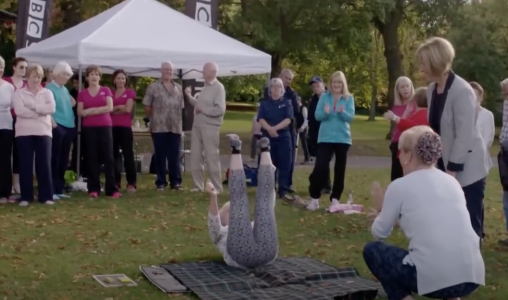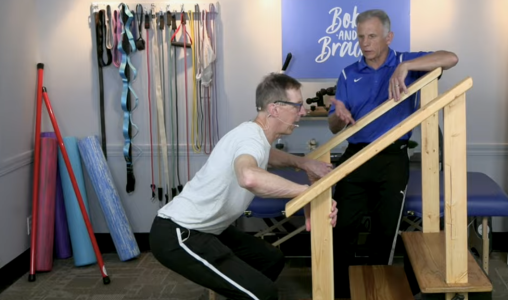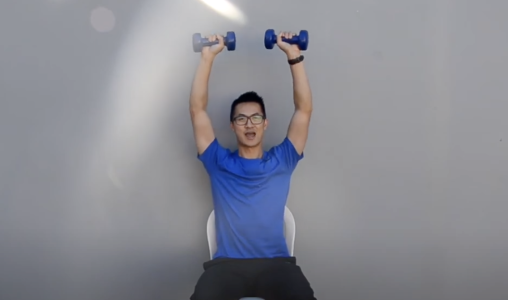How young is your body, really? Try these 5 moves to find out!
- Replies 0
Here at The GrayVine, we know that age is just a number—especially when you’re living life to the fullest in your 60s and beyond.
But wouldn’t it be nice to have a quick, no-nonsense way to check if your body is keeping up with your youthful spirit?
Good news: science and fitness experts agree that there are five simple moves that can reveal just how young your body really is. If you can perform these exercises with confidence, you might just be decades younger—at least on the inside!
Why Strength Matters More Than Ever
Let’s get one thing straight: being “fit” at 60 doesn’t mean running marathons or twisting yourself into a pretzel.
According to Luke Carlson, a leading exercise physiologist and founder of Discover Strength, the real secret to staying young isn’t about endless cardio or stretching—it's about getting strong.
“There is no fountain of youth, but there is strength training,” Carlson says. And he’s not alone.
Research shows that maintaining muscle mass and strength is one of the best ways to keep your metabolism humming, your bones sturdy, and your independence intact.

As we age, our muscles naturally lose some of their power, especially those 'fast twitch' fibers that help us move quickly and react to life’s little surprises (like catching yourself if you trip on the garden hose).
The good news? You can slow—and even reverse—this decline with the right moves.
The 5-Move Youth Test
Ready to see how you stack up? Here are the five expert-approved exercises that test your strength, balance, and overall vitality.
If you can do these, you’re not just keeping up—you’re leading the pack! But please remember to exercise caution when doing these exercises. Make sure to avoid getting hurt!
1. Leg Press or Bodyweight Squat
Why it matters: Strong legs are your ticket to independence. They help you climb stairs, get out of chairs, and keep your balance.
How to do it:
- Stand tall, feet shoulder-width apart.
- Lower into a squat, keeping your chest up and your weight in your heels.
- Go as low as you comfortably can—ideally until your thighs are parallel to the floor.
- Press back up to standing.
Leg press for seniors tutorial. Source: eHowFitness / Youtube.
No fancy equipment? No problem! Bodyweight squats are just as effective for testing your strength.
2. Chest Press or Push-Up
Why it matters: A strong chest and triceps make everyday tasks—like pushing open heavy doors or lifting groceries—a breeze.
Best step push ups for seniors. Source: Margaret Martin, PhD / Youtube.
How to do it:
- Lie on your back on a bench (or the floor), holding a dumbbell in each hand.
- Press the weights up over your chest, arms extended but not locked.
- Lower with control.
No dumbbells? Try a classic push-up, even if it’s from your knees or against a wall.
Also read: How to increase muscle growth after 60 with these 10 simple exercises
3. Row or Lat Pulldown
Why it matters: Your back muscles are the unsung heroes of good posture and pain-free living.
Source: Beyond Fitness Coaching / Youtube.
How to do it:
- Sit at a rowing or lat pulldown machine, grip the bar with hands shoulder-width apart.
- Pull the bar down to your upper chest, squeezing your shoulder blades together.
- Slowly release.
No gym? Try a resistance band row or even a sturdy doorframe row at home.
4. Shoulder Press
Why it matters: Strong shoulders and triceps help you reach high shelves, carry bags, and keep your upper body stable.
How to do it:
- Stand tall, dumbbells at shoulder height.
- Press the weights overhead until your arms are fully extended.
- Lower with control.
Start light and focus on good form—no need to impress anyone but yourself!
Also read: Want to move with ease as you age? Try these 4 easy exercises!
5. Lower Back Extension
Why it matters: A strong lower back is your best defense against chronic pain and injury.
Superman exercise. Source: Children’s Hospital Colorado / Youtube.
How to do it:
- Use a back extension bench, feet locked in, hips just above the pad.
- Cross your arms or hold a light weight.
- Lower your upper body toward the ground, keeping your spine neutral.
- Lift back up until your body forms a straight line from head to heels.
- Pause, then lower with control.
No bench? Try “Supermans” on the floor: lie face down, lift your arms and legs off the ground, hold, and release.
How Did You Do?
If you can perform these five moves with good form and without pain, give yourself a gold star!
You’re not just keeping up with your peers—you’re outpacing them. These exercises aren’t just about looking good; they’re about living well, staying independent, and enjoying all the adventures life still has in store.
Read next: Simple chair exercises every older adult can do to improve balance and strength at home

Have you tried these moves? Which one is your favorite—or the most challenging? Do you have a tip for staying strong and active in your 60s and beyond? We’d love to hear from you! Drop a comment below and let’s inspire each other to keep moving, keep growing, and keep living vibrantly—no matter what the calendar says.
But wouldn’t it be nice to have a quick, no-nonsense way to check if your body is keeping up with your youthful spirit?
Good news: science and fitness experts agree that there are five simple moves that can reveal just how young your body really is. If you can perform these exercises with confidence, you might just be decades younger—at least on the inside!
Why Strength Matters More Than Ever
Let’s get one thing straight: being “fit” at 60 doesn’t mean running marathons or twisting yourself into a pretzel.
According to Luke Carlson, a leading exercise physiologist and founder of Discover Strength, the real secret to staying young isn’t about endless cardio or stretching—it's about getting strong.
“There is no fountain of youth, but there is strength training,” Carlson says. And he’s not alone.
Research shows that maintaining muscle mass and strength is one of the best ways to keep your metabolism humming, your bones sturdy, and your independence intact.

At age 60, being able to perform key strength exercises like squats, chest press, rowing/pulldown, shoulder press and lower back extension is a sign your body is much younger than your years. Image source: BBC / Youtube.
As we age, our muscles naturally lose some of their power, especially those 'fast twitch' fibers that help us move quickly and react to life’s little surprises (like catching yourself if you trip on the garden hose).
The good news? You can slow—and even reverse—this decline with the right moves.
The 5-Move Youth Test
Ready to see how you stack up? Here are the five expert-approved exercises that test your strength, balance, and overall vitality.
If you can do these, you’re not just keeping up—you’re leading the pack! But please remember to exercise caution when doing these exercises. Make sure to avoid getting hurt!
1. Leg Press or Bodyweight Squat
Why it matters: Strong legs are your ticket to independence. They help you climb stairs, get out of chairs, and keep your balance.
How to do it:
- Stand tall, feet shoulder-width apart.
- Lower into a squat, keeping your chest up and your weight in your heels.
- Go as low as you comfortably can—ideally until your thighs are parallel to the floor.
- Press back up to standing.
Leg press for seniors tutorial. Source: eHowFitness / Youtube.
No fancy equipment? No problem! Bodyweight squats are just as effective for testing your strength.
2. Chest Press or Push-Up
Why it matters: A strong chest and triceps make everyday tasks—like pushing open heavy doors or lifting groceries—a breeze.
Best step push ups for seniors. Source: Margaret Martin, PhD / Youtube.
How to do it:
- Lie on your back on a bench (or the floor), holding a dumbbell in each hand.
- Press the weights up over your chest, arms extended but not locked.
- Lower with control.
No dumbbells? Try a classic push-up, even if it’s from your knees or against a wall.
Also read: How to increase muscle growth after 60 with these 10 simple exercises
3. Row or Lat Pulldown
Why it matters: Your back muscles are the unsung heroes of good posture and pain-free living.
Source: Beyond Fitness Coaching / Youtube.
How to do it:
- Sit at a rowing or lat pulldown machine, grip the bar with hands shoulder-width apart.
- Pull the bar down to your upper chest, squeezing your shoulder blades together.
- Slowly release.
No gym? Try a resistance band row or even a sturdy doorframe row at home.
4. Shoulder Press
Why it matters: Strong shoulders and triceps help you reach high shelves, carry bags, and keep your upper body stable.
How to do it:
- Stand tall, dumbbells at shoulder height.
- Press the weights overhead until your arms are fully extended.
- Lower with control.
Start light and focus on good form—no need to impress anyone but yourself!
Also read: Want to move with ease as you age? Try these 4 easy exercises!
5. Lower Back Extension
Why it matters: A strong lower back is your best defense against chronic pain and injury.
Superman exercise. Source: Children’s Hospital Colorado / Youtube.
How to do it:
- Use a back extension bench, feet locked in, hips just above the pad.
- Cross your arms or hold a light weight.
- Lower your upper body toward the ground, keeping your spine neutral.
- Lift back up until your body forms a straight line from head to heels.
- Pause, then lower with control.
No bench? Try “Supermans” on the floor: lie face down, lift your arms and legs off the ground, hold, and release.
How Did You Do?
If you can perform these five moves with good form and without pain, give yourself a gold star!
You’re not just keeping up with your peers—you’re outpacing them. These exercises aren’t just about looking good; they’re about living well, staying independent, and enjoying all the adventures life still has in store.
Read next: Simple chair exercises every older adult can do to improve balance and strength at home
Key Takeaways
- At age 60, being able to perform key strength exercises like squats, chest press, rowing/pulldown, shoulder press and lower back extension is a sign your body is much younger than your years.
- Experts say focusing on strength training is more important than just increasing activity, flexibility, or mobility as you get older.
- Performing these movements helps counteract age-related muscle decline, particularly the loss of fast twitch muscle fibres that are vital for strength.
- Regularly practising these five exercises can improve muscle mass, strength, and even support metabolic and back health well into your 60s and beyond.
Have you tried these moves? Which one is your favorite—or the most challenging? Do you have a tip for staying strong and active in your 60s and beyond? We’d love to hear from you! Drop a comment below and let’s inspire each other to keep moving, keep growing, and keep living vibrantly—no matter what the calendar says.








